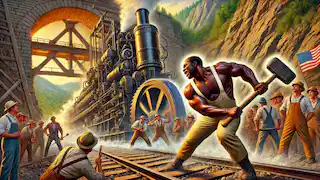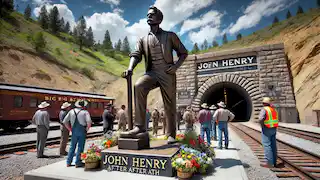John Henry, one of the most legendary figures in American folklore, was known as the "Steel-Driving Man." His story is rooted in the late 19th century during the construction of the great railroads that spanned the United States. It is a tale of grit, determination, and the human spirit standing against the unstoppable forces of industrial progress. His strength and courage became the foundation of a story that reflects the struggles, triumphs, and heartaches of an era that transformed America. John Henry was born into a world of hardship and hope in the post-Civil War South. He grew up in a small, humble cabin, where his parents, who had once been slaves, instilled in him the values of hard work, resilience, and integrity. Even as a child, John stood out. He was taller, broader, and stronger than the other boys. By the age of twelve, he was already doing the work of a grown man, splitting wood, hauling bales of cotton, and plowing fields. His strength was legendary even in those early years, and folks whispered that he was born with iron in his bones. When John Henry reached adulthood, he left home to seek his fortune. He wandered for miles, working wherever he could find a job. He labored in fields, forests, and quarries, always with a sledgehammer in hand. His reputation grew as the strongest man anyone had ever seen. Eventually, he found his way to the great railroad companies that were laying tracks across the nation. It was there, at the base of the Allegheny Mountains, that John Henry’s story truly began. Railroad work was grueling, and the men who toiled on the tracks were as tough as the steel they laid. The company was racing against time to complete the Big Bend Tunnel, a massive project that would carve a path through solid rock in West Virginia. It was back-breaking labor, and it was here that John Henry stood head and shoulders above the rest, swinging his hammer with an unyielding rhythm. The crew of workers was diverse, with men from every corner of the country, and even some from overseas, all drawn together by the promise of work and a better life. They worked under the searing sun, through pouring rain, and even in the bitter cold. They were paid meager wages for their efforts, but for many, it was the only work available. John Henry quickly became a leader among the men. When morale was low, he would sing, his deep voice booming through the valley. “I’ll die with a hammer in my hand, Lord, Lord,” he would chant, and the men would join him, their spirits lifted by his unyielding strength and determination. One sweltering summer day, the foreman of the railroad crew, a wiry man named Captain Tommy, announced that a new machine was coming to the camp – a steam-powered drill. This machine, the foreman claimed, could outwork any man, driving steel spikes into the rock faster than any human could swing a hammer. The workers muttered among themselves, fearing that this invention would soon make them all obsolete. John Henry stepped forward, his eyes blazing with defiance. “Ain’t no machine that can beat a man’s heart and soul,” he declared. “I’ll challenge that steam drill myself.” Captain Tommy chuckled, but he saw something in John Henry’s eyes that gave him pause. “Alright, John,” he said, “you want to race the machine? You got it. Tomorrow at sunrise, we’ll see who’s faster.” The word spread like wildfire, and by the next morning, men, women, and even children gathered to witness the showdown between man and machine. It wasn’t just a competition; it was a test of the human spirit, a symbol of the battle between progress and the strength of the human heart. At dawn, the challenge began. The steam drill roared to life, spewing clouds of steam as it dug into the rock. Its pistons pumped furiously, and the sound was deafening. But John Henry stood undaunted, gripping his two twenty-pound hammers, one in each hand. With a mighty swing, he struck the first blow, the clang of steel on rock echoing across the valley. For hours, man and machine fought side by side. The crowd watched in awe as John Henry matched the machine blow for blow. Sweat poured from his body, his muscles straining with every swing, but he refused to slow down. The drill hissed and clattered, but John’s hammer rang out clear and true, each strike hitting with the force of thunder. By noon, it was clear that John Henry was gaining on the machine. The drill’s operator frantically adjusted valves and gauges, trying to coax more speed from the contraption, but it was no use. John Henry’s hammer fell in a steady, relentless rhythm, and with every swing, he edged closer to victory. As the sun began to set, John Henry struck his final blow, driving the steel spike deeper than the steam drill ever could. The crowd erupted in cheers, their voices echoing through the mountains. John Henry had won! He had proven that no machine could outwork the heart and soul of a man. But as the cheers died down, John Henry staggered. His face was pale, and his breath came in ragged gasps. He fell to his knees, clutching his chest. The strain of the day’s work had been too much for even him. As he collapsed to the ground, his last words were a whisper, “A man ain’t nothing but a man. But a man can do more than a machine.” The crowd fell silent as John Henry took his last breath. The railroad workers, their faces streaked with sweat and dirt, lowered their heads in respect. They knew that they had witnessed something extraordinary, something that would be remembered for generations. John Henry’s death was not in vain. His story spread far and wide, becoming a symbol of strength, perseverance, and the indomitable human spirit. The railroad company, in honor of his sacrifice, carved a statue of John Henry at the entrance of the Big Bend Tunnel, his hammer held high, forever frozen in that moment of triumph. Workers who passed through the tunnel would pause to pay their respects, and they would tell the story of John Henry to their children and grandchildren. Songs were written about him, tales were told around campfires, and his name became synonymous with heroism and endurance. For years to come, people would speak of the day when John Henry faced the steam drill. They would talk about how he proved that there is something in the heart of a man that no machine can ever replace. And though the railroads would continue to expand, and the machines would become more advanced, the story of John Henry would always remind them that progress should never come at the cost of the human soul. In time, the Big Bend Tunnel became just another part of the sprawling railroad network that connected the nation. The steam drills became more efficient, and the era of the steel-driving man faded into history. But the memory of John Henry lived on. His story was passed down from generation to generation, a tale of courage, strength, and the power of the human spirit to overcome even the greatest challenges. Today, the legend of John Henry stands as a reminder of a time when men and women faced incredible odds, working with their hands, their hearts, and their souls. It is a story that speaks to the eternal struggle of humanity to find purpose, meaning, and dignity in the face of change. And as long as there are those who are willing to pick up a hammer, who are willing to stand against the tide and say, “I’ll do it myself,” the spirit of John Henry will never die.The Beginning
The Call to the Mountains
The Challenge of the Steam Drill
The Great Race

Victory and Tragedy

The Legacy of John Henry

Epilogue

John Henry
Reading Time: 7 min

About Story: John Henry is a Legend Stories from united-states set in the 19th Century Stories. This Dramatic Stories tale explores themes of Perseverance Stories and is suitable for All Ages Stories. It offers Inspirational Stories insights. The legendary race of man versus machine that defined an era.

















